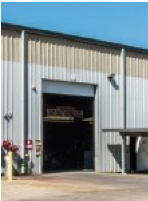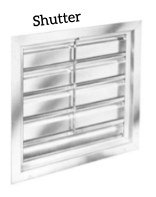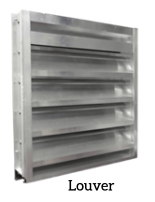Speed Kills
We have all heard the term “speed kills” as it relates to the dangers of driving a motor vehicle too fast. But when it comes to a general ventilation system, high air speed can “kill” or severely impact the ventilation system’s intended performance. In this article, we will discuss why Eldridge takes air speed into consideration, in addition to air flow and pressure drops, when designing a ventilation system.
Problems with High Air Speed
 Recently, I was on a site visit to a customer that had a powered exhaust and gravity supply ventilation system. The primary air supply sources were two truck doors located at the long ends of the building. With all of the fans and dust collectors on, the air speed through the truck doors was over 700 feet per minute (ft/min). Dust control and negative pressure are two common problems with an air speed this high. The customer was already having problems controlling dust from the manufacturing operations within the building and the high air speed through the truck doors was adding to the problem because it was picking up all of the dust kicked up around the truck door openings. Second, if the customer were to try and close either of the truck doors, the resulting build-up of negative pressure in the building would pose a safety problem opening and closing man doors to the attached offices.
Recently, I was on a site visit to a customer that had a powered exhaust and gravity supply ventilation system. The primary air supply sources were two truck doors located at the long ends of the building. With all of the fans and dust collectors on, the air speed through the truck doors was over 700 feet per minute (ft/min). Dust control and negative pressure are two common problems with an air speed this high. The customer was already having problems controlling dust from the manufacturing operations within the building and the high air speed through the truck doors was adding to the problem because it was picking up all of the dust kicked up around the truck door openings. Second, if the customer were to try and close either of the truck doors, the resulting build-up of negative pressure in the building would pose a safety problem opening and closing man doors to the attached offices.
Measurement Points
 There are several points in a general ventilation system where air speed is concerning. Let’s start with supply hoods. The concern here is that the air speed at the entry to the hood will be too high and that water will be pulled in. The general rule of thumb is that air speed below 1,000 ft/min will keep out rain and below 400 ft/min will keep out snow. When rating the effectiveness of their hoods for water penetration, too many of our competitor’s will rate their hoods based on average air speed across the opening knowing that the actual air speed at the edge of the hood opening closest to the fan will be over 1,000 ft/min. That is why when Eldridge designed our E-Hive hoods, we measured the speed at all points of the openings to guarantee that the air speed will not cause water penetration.
There are several points in a general ventilation system where air speed is concerning. Let’s start with supply hoods. The concern here is that the air speed at the entry to the hood will be too high and that water will be pulled in. The general rule of thumb is that air speed below 1,000 ft/min will keep out rain and below 400 ft/min will keep out snow. When rating the effectiveness of their hoods for water penetration, too many of our competitor’s will rate their hoods based on average air speed across the opening knowing that the actual air speed at the edge of the hood opening closest to the fan will be over 1,000 ft/min. That is why when Eldridge designed our E-Hive hoods, we measured the speed at all points of the openings to guarantee that the air speed will not cause water penetration.
The second point of concern with air speed is with any shutter that is located adjacent to a fan. The danger here is that high air speeds may blow out the shutter blades and injure people or damage equipment. A standard shutter on an Eldridge Fan can be used with air speeds up to 2,500 ft/min. When Eldridge is designing a ventilation system, if there is a restriction that keeps us from increasing the size of the fan to lower the air speed, then we will use a heavy duty shutter that can handle the higher air speed.
The third place to check the air speed is at any louver in the ventilation system. If it is a supply air louver, high air speed through the louver may pull in water. Most louver manufacturers will provide a chart showing the amount of water penetration at a range of air speeds. This is important because not all louvers will prevent water penetration below 1,000 ft/min.  If it is an exhaust air louver, high air speed through the louver may cause an excessively high amount of positive pressure in the building and that could pose a safety problem when opening and closing man doors. When sizing louvers, Eldridge makes sure to allow for sufficient open area to prevent the air speed through the louver from causing these problems.
If it is an exhaust air louver, high air speed through the louver may cause an excessively high amount of positive pressure in the building and that could pose a safety problem when opening and closing man doors. When sizing louvers, Eldridge makes sure to allow for sufficient open area to prevent the air speed through the louver from causing these problems.
Lastly, we check the air speed though unrestricted openings such as doors. As in the example above, dust penetration could be a problem depending on the air speed and conditions around the opening. In this situation, we might recommend a positive pressure ventilation system to keep out the dust regardless of the air speed through openings. Also, excessive air speed though open doors can lead to potential safety problems when they are closed. When we are designing a ventilation systems that will utilize open doors for air flow, we will recommend that there be a pressure relief damper to prevent dangerous pressure build-up.
Conclusion
After reading this article you can now understand why when Eldridge is designing a ventilation system to meet a customer’s requirements we are concerned with air speeds at several points in the system. Excessive air speeds can severely impact how the ventilation system performs. Eldridge provides the dual guarantee of ventilation system performance and product durability.

